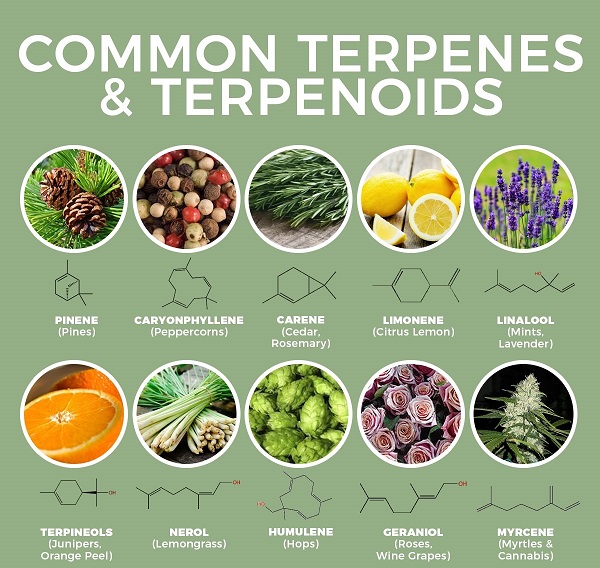Within the captivating realm of cannabis, a multitude of compounds intricately collaborate to create its distinctive effects and scents. Among these compounds, terpenes stand out as remarkable aromatic molecules that not only contribute to the captivating fragrance of cannabis but also play a crucial role in shaping its therapeutic potential. With the surge of interest in the cannabis industry and the expanding recognition of its medicinal properties, a deeper understanding of terpenes and their relationship with the renowned psychoactive component THC (tetrahydrocannabinol) has become a subject of keen exploration.
In this article, we embark on a journey through the aromatic world of THC terpenes, delving into the captivating chemistry and diverse effects these compounds possess. We will unravel the fascinating interplay between terpenes and THC, shedding light on how these aromatic components work together to create the entourage effect—a phenomenon wherein the combined action of multiple cannabis compounds produces a more profound impact than their individual effects alone.
Where do terpenes come from?

Terpenes, the naturally-occurring compounds found within the trichomes of female cannabis plants, hold a vital role in the plant’s growth and survival. These translucent, sticky glands that cover the surface of buds, leaves, and stems contain resin glands responsible for the production of terpenes.
Aside from lending cannabis its distinct aromas, terpenes contribute to the plant’s vibrant coloration and pigmentation, as well as its overall flavor. Remarkably, these organic compounds serve a dual purpose by attracting beneficial creatures while deterring potential harm-causing insects or herbivores.
For instance, terpenes like geraniol act as repellents, warding off pests that might attempt to consume the cannabis plant. Conversely, terpenes such as terpinolene and linalool entice insects and small creatures that aid in pollination, facilitating the spread of pollen. By conveying environmental information, terpenes bolster the plant’s immune system, shielding it against stressors, pathogens, and triggering immune responses.
Various factors influence the production of terpenes in cannabis plants. Variables such as outdoor or indoor cultivation, light exposure, temperature, growing mediums, nutrient levels, and the timing of harvest all play a significant role in determining terpene levels.
The volatile nature of many terpenes poses a challenge during standard cannabis extraction processes, as they can be easily lost. However, the growing recognition of the therapeutic value of terpenes has led to the development of more sensitive extraction methods, such as live resin.
Live resin extraction involves using fresh frozen cannabis plants and maintaining freezing temperatures throughout the extraction process. This meticulous approach protects the delicate terpenes and other volatile compounds present in the plant, resulting in a cannabis product that offers a more complex aroma profile and a truly flavorful experience.
As awareness grows regarding the significance of terpenes, their preservation and incorporation into cannabis products hold tremendous potential for enhancing the overall quality and therapeutic value of the plant. By embracing extraction methods like live resin, enthusiasts can savor the full symphony of aromas and flavors that terpenes offer, embarking on an elevated cannabis journey like never before.
How do terpenes affect the body?
Terpenes, despite not being psychoactive themselves, can exert various effects on the body when consumed or inhaled along with other cannabis compounds. These effects are believed to be influenced by the interaction of terpenes with other cannabinoids, particularly THC and CBD, as well as their individual actions on receptors and biological pathways. While research in this field is still evolving, here are some of the ways terpenes may impact the body:
- Modulation of Neurotransmitters: Terpenes can interact with neurotransmitter systems in the brain, potentially influencing mood, cognition, and behavior. For example, the terpene limonene may have mood-elevating and stress-reducing effects by interacting with serotonin and dopamine receptors.
- Enhancement of the Entourage Effect: Terpenes are known to contribute to the entourage effect, a synergistic interaction among cannabinoids and other cannabis compounds. This phenomenon suggests that terpenes can modify the effects of THC, CBD, and other cannabinoids, enhancing or modulating their therapeutic potential.
- Interaction with Receptors: Terpenes may interact with various receptors in the body, including cannabinoid receptors (CB1 and CB2), GABA receptors, serotonin receptors, and vanilloid receptors. These interactions can affect pain perception, inflammation, mood regulation, and more.
- Potential Anti-inflammatory and Analgesic Effects: Some terpenes, such as myrcene and beta-caryophyllene, have shown anti-inflammatory properties and may act as analgesics by reducing pain sensations.
- Anxiety and Stress Reduction: Certain terpenes, including linalool and beta-caryophyllene, have demonstrated potential anxiolytic effects, promoting relaxation and reducing stress and anxiety symptoms.
- Sedation and Sleep Promotion: Terpenes like myrcene and linalool have been associated with sedative properties and may aid in sleep induction and improving sleep quality.
- Antimicrobial and Antioxidant Activity: Several terpenes possess antimicrobial and antioxidant properties, which may contribute to their potential health benefits and protective effects on the body.
It’s important to note that the effects of terpenes can vary depending on their concentration, the specific combination with other cannabis compounds, and individual differences among users. Further research is needed to fully understand the mechanisms and therapeutic potential of terpenes in the context of human health and well-being.
How can terpenes contribute to the effects of cannabis?

Terpenes play a significant role in shaping the effects of cannabis by interacting with other compounds, such as cannabinoids, and influencing the way they interact with the body’s receptors and systems. Here are some ways in which terpenes contribute to the effects of cannabis:
- Modulating Cannabinoid Receptors: Terpenes can interact with cannabinoid receptors (CB1 and CB2) in the endocannabinoid system, potentially influencing the binding affinity and activity of cannabinoids like THC and CBD. This interaction can enhance or modify the overall effect of cannabinoids on the body.
- Synergistic Effects: Terpenes work in synergy with cannabinoids to create what is known as the entourage effect. This refers to the combined effect of multiple compounds in cannabis, including terpenes, cannabinoids, and other constituents, producing a more profound impact than the effects of individual compounds alone. The presence of specific terpenes alongside cannabinoids can enhance or modulate their therapeutic potential and overall effects.
- Influence on Blood-Brain Barrier: Some terpenes, such as limonene and pinene, have been shown to affect the permeability of the blood-brain barrier. This barrier protects the brain from potentially harmful substances. By modifying its permeability, terpenes may affect the bioavailability and distribution of cannabinoids in the central nervous system, influencing the onset and intensity of their effects.
- Aromatherapy and Olfactory Effects: Terpenes contribute to the distinctive aroma and flavor profiles of different cannabis strains. The olfactory system plays a role in the overall cannabis experience, and the aromatic compounds can evoke certain moods, memories, and sensations. Inhalation of terpenes through methods like vaporization or aromatherapy can have direct effects on mood, relaxation, and sensory perception.
- Individual Terpene Effects: Different terpenes have their own unique properties and potential effects on the body. For example, the terpene myrcene is associated with sedative and relaxing effects, while limonene may have mood-elevating and stress-reducing properties. The presence and concentration of specific terpenes in a cannabis strain contribute to its overall effect profile and can guide users in selecting strains that align with their desired effects.
It’s important to note that the effects of terpenes can vary depending on the specific combination and concentration of terpenes present in a cannabis strain, as well as individual factors such as body chemistry and tolerance. Understanding the interplay between terpenes and cannabinoids provides insights into the complex effects of cannabis and enables users to make more informed choices based on their desired outcomes.
The top three terpenes found in cannabis
The cannabis plant contains a wide range of terpenes, each with its own unique aroma and potential effects. While there are many terpenes present in cannabis, the following three are among the most commonly found:
- Myrcene: Myrcene is one of the most abundant terpenes in cannabis and is also found in other plants such as hops, mangoes, and lemongrass. It has a musky, earthy aroma and is associated with sedative and relaxing effects. Myrcene is believed to enhance the permeability of cell membranes in the body, allowing for easier absorption of cannabinoids. It is often considered a key contributor to the “couch-lock” sensation often associated with indica strains.
- Limonene: Limonene is a terpene known for its citrusy, lemon-like aroma. It is not only found in cannabis but also in various citrus fruits and other plants. Limonene is believed to have uplifting and mood-enhancing effects and may also possess anti-anxiety and stress-relieving properties. It is often associated with sativa strains and is thought to contribute to their energizing and euphoric effects.
- Caryophyllene: Caryophyllene is a unique terpene as it can also act as a cannabinoid by binding to the CB2 receptors of the endocannabinoid system. It has a spicy, peppery aroma and is found in many spices such as black pepper and cloves. Caryophyllene is believed to have anti-inflammatory and analgesic properties and may contribute to the “body high” sensation often associated with certain cannabis strains.
It’s important to note that the effects of these terpenes can vary depending on their concentration, the specific combination with other terpenes, and the presence of different cannabinoids. The overall effect of a cannabis strain is influenced by the collective presence and interaction of various terpenes and cannabinoids, creating a unique and personalized experience for each user.
Conclusion
The world of THC terpenes within cannabis is a captivating realm that goes beyond mere aroma and flavor. These organic compounds contribute to the unique effects and therapeutic potential of cannabis, enhancing its allure and customization for users.
Terpenes not only interact with cannabinoid receptors and modulate the effects of THC and CBD but also exhibit their own individual properties, such as mood elevation, relaxation, pain relief, and anxiety reduction. Their presence and combination in cannabis strains create a symphony of effects that can be tailored to suit individual preferences and medicinal needs.
As research in this field continues to expand, a deeper understanding of THC terpenes holds great promise for unlocking new frontiers in wellness, pleasure, and therapeutic applications. By embracing the intricate interplay between terpenes and other cannabis compounds, users can delve into a realm of personalized experiences, taking their cannabis encounters to new heights.












